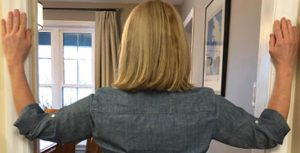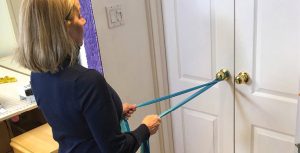Eat-Sleep-Move might be good for the average soul, but for “sew-cialites” it is Eat-Sleep-Move-Sew — not necessarily in that order. Many quilters forget to eat, think that sleep is a waste of time and never get up and move away from the sewing machine. How often have you said to yourself you were simply going to sew for a “little bit” – just one block, a few HSTs (half square triangles) or maybe get that binding ready for tomorrow? How often has your “little bit” turned into hours of fun?
Your body is not designed to be in one position for hours on end, like when seated at your machine, so you are bound to develop tight muscles which mimic that position. In this case, you are likely to experience tight, overused chest muscles and weaker, underused back muscles. It is like the chicken and the egg as to which comes first. Poor posture leads to tight chest muscles, which leads to a stiff back, which leads to poor posture. You might notice your chest is tight because you feel hunched over. Even though people tell you that you look fine, you can feel yourself caving in as your chest muscles draw in and down or your neck and shoulders are sore.

Two things to do regularly is stretch your chest (the pectorals) and strengthen the muscles between your shoulder blades (the rhomboids and middle trapezius). A lot of stretches for quilters can be done right at your machine and this one is easy:
- Lean back in your chair and open your arms wide, feel your chest and lungs expand.
- Take several deep breaths and hold for 20 to 60 seconds.

Better yet, get up and move a little and try a doorway stretch:
- With palms flat on either side, line up your forearms against the side of a doorway. Slowly step one leg through and hold.
- Take several deep breaths and hold for 20 to 60 seconds.

A seated or standing row is effective for strengthening your back muscles.
- Anchor a resistance band around a door handle or heavy stationary item slightly higher than waist height.
- Stand two to three feet back, holding ends of the resistance band in your hands.
- Roll shoulders back, keep your feet hip-width apart or stagger your stance. Keep your chest up and eyes looking straight ahead.
- Brace your core, draw in your shoulder blades, arms straight out in front of you with palms facing each other.
- Draw your elbows back and down, skimming them past the sides of your body. Your upper and lower arm should end at 90°.
- Control the resistance as you return to the starting position.
- Repeat five to ten times.
Note: Do not let your palms turn up as you pull back, this mistake can ignite the biceps. Likewise, if hands face down, you may activate the triceps instead of your middle and upper back.
Getting up to move is best because it not only gets your blood moving, it also warms you up. If a seated row is for you, at least try to do a few shoulder and ankle rolls before you start.
- Anchor your band right around your sewing table leg and perform the stretch as listed previously.
- Be sure to brace the table leg with your foot or you will pull the table towards you.
For more helpful, healthy information about keeping your body at its quilting best, please visit Rose’s website.


